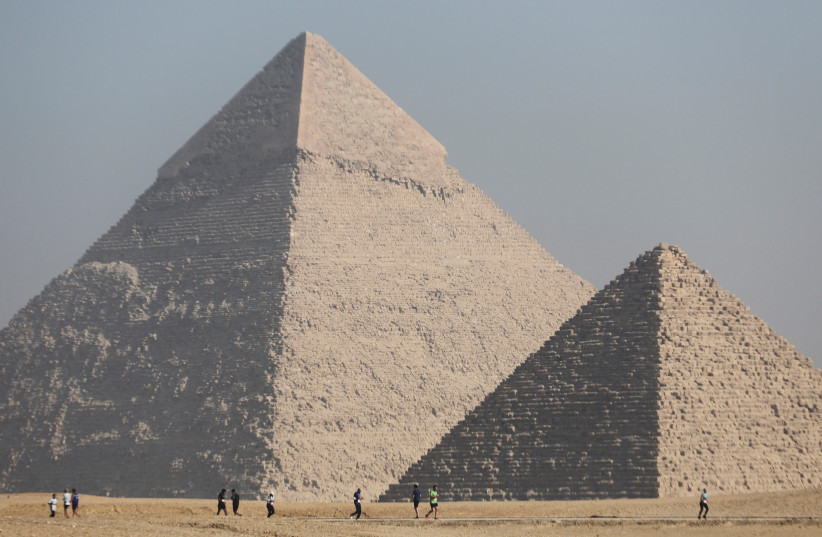The Great Pyramids of Giza are arguably the most recognizable landmarks and monuments in human history.
Built thousands of years ago in ancient Egypt, the pyramids have captivated humanity for as long as they have been around. They've been long featured on different lists and compilations of most amazing and awe-inspiring structures, even the original listicle: The Seven Wonders of the Ancient World - of which it is the only one that is still around.
However, the sheer scale of the pyramids have left many puzzled at how they could have even been built. This has led to outlandish misconceptions and conspiracy theories, ranging from aliens to long-lost civilizations.
But how were the pyramids built? It turns out, science and history has a lot of the answers.
Here's everything you need to know.
When were the Great Pyramids built?
There are three pyramids and a few subsidiary pyramids at the Giza pyramid complex: The Great Pyramid being the largest and most famous.
All of them, however, were built around the same time, between 2600 BCE and 2500 BCE during the reign of the Fourth Dynasty of the Old Kingdom period.
It was also around this time that another monument close to the pyramids was constructed: The Great Sphinx.
The Great Pyramid itself is also known as the Pyramid of Khufu. The other two are the Pyramid of Khafre and the Pyramid of Menkaure. Each of them served as tombs for the pharaohs they were named after.
What materials and stones were used in the construction of the Great Pyramids?
The pyramids were built by large and heavy blocks of stone. In the case of the Great Pyramid itself, it was made mostly of limestone and to a lesser extent, granite.
This was a monumental task, with around 2.3 million blocks used, totaling several million tons of limestone, granite, and mortar.
Sourcing these materials was no simple feat. The limestone is believed to have been sourced from Giza directly. Another kind of limestone used, white limestone, which was part of the casing of the pyramid, was known through deciphered records found by archaeologists to have originated in nearby Tura.
However, the granite is thought to be more distant, coming from faraway Aswan in the South. Despite being incredibly heavy, the granite was still able to be transported by boat across the Nile River.
What construction techniques and tools were employed to build the Great Pyramids?
This is easily one of the biggest sources of disagreement and debate regarding the pyramids, and it has been the fuel of many misconceptions and conspiracy theories.
Unfortunately, due to how long ago this took place and not all records surviving, there is simply so much historians can't prove one way or the other.
While many issues related to pyramid construction can be answered, such as how the stones were mined and brought to the building site - the latter of which seemed to be definitively proven by the 2013 discovery of a diary by an Egyptian official, which explained how stones were shipped to Giza by boat.
However, the biggest question is in how the stones themselves were brought up the pyramid itself. This would have been a very difficult task, given how heavy a single stone was - and how fast the pyramid was supposedly constructed.
While we absolutely do not know for sure which methods were used, there are many possibilities put forward by historians throughout history.
What most historians agree on is that ramps were somehow used. While there are a lot of questions about how these ramps would have worked, one considerable issue with it is that a ramp alone wouldn't be enough.
For instance, a simple straight line ramp would have been extremely large and costly, and despite this there is no archaeological evidence such a massive ramp was used.
A number of other ramps were proposed, but historians are still heavily divided on this. What most agree upon as a result is that while ramps were certainly used to an extent, something else would needed to be used too.
Here is where things get interesting.
One of the earliest historical records of how the pyramids were constructed was the writings of Herodotus, the ancient Greek historian.
Herodotus is often said to have created the idea of a historian, but his actual work has been highly suspect and its reliability in question. Despite this, his writings about ancient Egypt have often been seen as more reliable, given corroboration with other sources and the feasibility of him actually traveling to Egypt in the first place.
According to Herodotus, the ancient Egyptians made use of a certain machine. While no one is quite sure what this machine is, as no depiction of it or schematics exist apart from Herodotus's statements, historians and engineers can infer some details. For one thing, it was a lever, and would supposedly allow stones to be lifted.
There is considerable evidence to support this. Not only does it work in terms of physics, but the Egyptians could have feasibly had such technology. For example, one commonly-cited piece of technology that existed at the time was the shadoof, a lever-based irrigation tool that essentially let people take water from one place to another in a very efficient manner.
The shadoof is one of history's most notable and reliable inventions and has been used for thousands of years, possibly even prehistoric times, and it was certainly used in the Old Kingdom in Egypt.
Combining the function of a shadoof with ramps, made to account for the weight of the stones, should, according to many experts, allow for these massive stones to be moved and placed in the right manner.
What labor force was involved in building the Great Pyramids?
Now this is another big question that has been surrounded by thousands of years of misconceptions.
The ancient Greeks were of the belief that the Egyptians used slaves to build the pyramids. However, this may not be true.
At the very least, the Great Pyramid of Giza is now widely believed to have been built by a vast army of professional workers, each of whom was paid for their work.
Supporting this is the fact that workers had essentially camped out by the construction site over time, as well as a vast number of graves in a nearby cemetery found in the 1990s where the laborers were buried.
Based on this, we know quite a bit about the laborers who built the pyramids, as shared in 2005 by Mansour Boraik, chief inspector for Egypt's Supreme Council of Antiquities, and as reported on at the time by Emory University.
According to Boraik, the laborers included both men and women, between the ages of 30 and 35 while the overseers and other officials were between 50 and 60. The workers' remains showed signs of built-up stress in the lower spine, which was a sign of heavy lifting. One of the laborers specifically was a pregnant woman with dwarfism.
What role did mathematics and astronomy play in constructing the Great Pyramids?
The mathematical aspect of the construction of the pyramids is rather obvious. The architects would need a very keen grasp on geometry and volume in order to organize and design such a massive project. Though at its core, the math is rather simple: Just make all the sides equal on a large 3D triangular structure.
As for astronomy, the ancient Egyptians had made strides in this field, and it shows in the construction of the pyramids. However, this has been overly misconstrued in popular culture.
Many Egyptian pyramids were built to be aligned to a star, and many have attributed this and similar astronomical claims to the Great Pyramid. However, many of these, such as the theory that they are meant to be reflective of Orion's Belt in the Orion constellation, are not widely accepted by archeologists.
Crucially, even if there was thorough understanding of astronomy that went into the construction of the pyramids, it would have reflected the night sky from over 4,000 years ago, and not what we have now.
What are the unresolved questions regarding the construction of the Great Pyramids?
As mentioned earlier, the biggest mysteries are still mostly related to how exactly the large stones were carried up the massive structure.
It is possible more evidence will be found by archaeologists. Otherwise, though, it is likely that these secrets will be lost to time.

